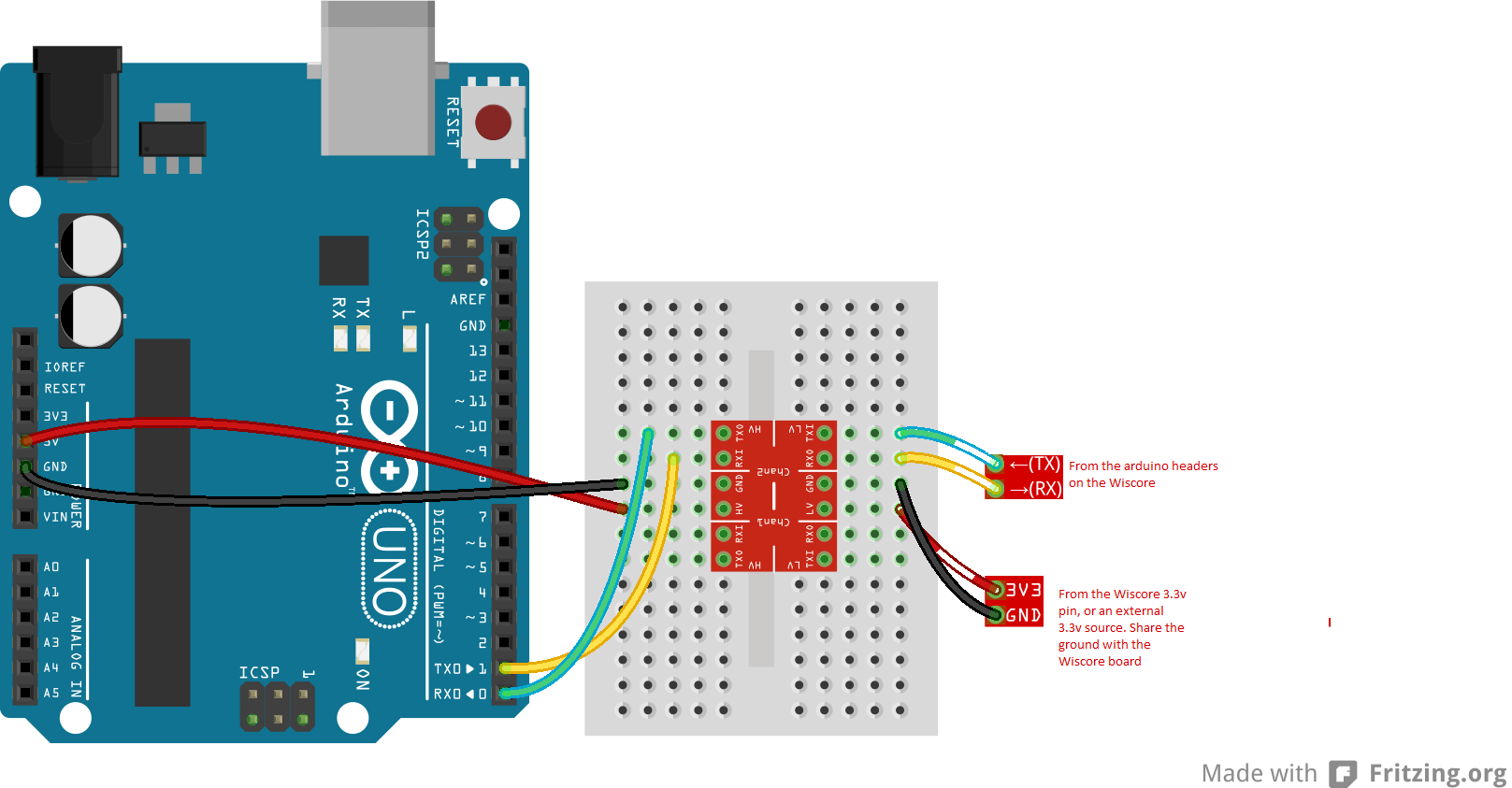As part of the series of tutorials for the Wiscore Alexa AVS EVK, we will see how to integrate Arduino boards (Uno, Leonardo, Due etc) directly with Alexa Voice Service. The Wiscore board provides the means to communicate with other devices via the UARTs. We will in depth on how to enable one of the UARTs, connect an Arduino to the EVK and then communicate over Serial. Another tutorial will cover getting the Yun Bridge ported to the device and how to use the Bridge APIs for operations
Getting your firmware with Uart2 EnabledThe Mt7628 chipset has 3 UARTs in total as described below:
- UART1: UART_RXD1 - GPIO#46 and UART_TXD1 - GPIO#45
- UART2 : MDI_TN_P2 - GPIO#21 and MDI_TP_P2 - GPIO#20
- UART0 : UART_RXD0 - GPIO#13 and UART_TXD0 - GPIO#12
UART0 is used for the serial debugging port exposed via the CH340 USB to serial chipset
UART 1 and UART 2 need to enabled on the firmware to be exposed to the user.
We need to edit the following .dts file in the Wiscore SDK to enable the UART1
- Clone the Wiscore SDK at: https://github.com/RAKWireless/WisCore-SDK
- Edit .dts
vi
WisCore-SDK/products/wisAvs/target/linux/ramips/dts/
MT7628.dts
- Add the following status to the UART1
- Then save file and re-compile the SDK
- Enter the system and you will see the device "ttyS1" of Uart1
ls /dev/
Finally, you can use Uart1.
- Configure the kernel module for UARt2 to be included into the build config
cd vi WisCore-SDK/products/wisAvs
make menuconfig
- kernel modules--->Other modules---><*>kmod-serial-8250---
- Enable ".dts" just like we did for UART 1
vi wiswrt/ rak
/ purewrt-rc2/target/linux/ramips/dts/MT7628.dts
- add uart2 status
Then save file and re-compile the SDK
- Enter the system and you will see the device "ttyS2" of Uart2
ls /dev
Now you can use the ttyS2 dev entry as Uart2
Installing some important tools:During the development of this feature, There are certain tools that are worthwhile to install.
- First install the packages repo in the Wiscore board
a. SSH into your wiscore board from a terminal program like putty.
b. Login as root. If you have not enabled root account on the wiscore then you can telnet to the same IP at port 23 instead of port 22 (SSH port)
c. Once inside the console. Cd to the directory
/etc/opkg.conf
d. And add the following lines at the end of the file:
src/gz chaos_calmer_packages https://downloads.openwrt.org/snapshots/trunk/ramips/mt7628/packages/packages/
e. Save the file and exit
- Run the command opkg update to get the latest packages form the newly added repo
- Install stty:
opkg install stty
- Install screen:
opkg install screen
- Install python:
opkg install python
The Python 2.7 package will take up lots of space. I had 19 percent storage left after installing all these packages.
Getting to know your UART1The UART1, as described in the previous section is on GPIO 45 and GPIO 46 (txd and rxd) and are exposed via the Arduino headers on the Wiscore Base Board (please refer to the picture in the previous section)
UARTs function at a particular speed called Baud Rate. If we communicate with the incorrect baud rate we will only see gibberish on the console. Here is where stty comes into play. To know the setting of UART1 on the Wiscore board type the following into the terminal session:
stty -F /dev/ttyS1 –a
On my board this command showed the baud rate as 115200. So for all future Arduino communication this would be the speed we have to use.
Screen is a command-line utility to open the serial port for communication. For brevity here is command to run to open up UART1:
screen /dev/ttyS1 115200
Now you can send characters from the terminal to the uart port.
Another quick test would be to echo some strings directly to the dev like so:
Echo hello world > /dev/ttyS1
Now we have the board setup for communication with an Arduino board. Here is how to connect you arduino with the Wiscore board.
If you use the Arduino Board like DUE which are 3.3v compatible. You can directly connect the wiscore UART pins to the UART pins on the Arduino.
Sample UART test to read and print some charcaters to the terminal:
void setup() {
// put your setup code here, to run once:
Serial.begin(115200);
}
void loop() {
// put your main code here, to run repeatedly:
while (Serial1.available()> 0) {
char ch = Serial1.read();
Serial.print(ch); // print the number as well
}
//delay(5000); // wait 5 seconds before you do it again
}
Now after uploading the sketch on the Arduino. Connect the Arduino UART to the Wiscore UART1 and send some characters from Wiscore to the Arduino. Open up the serial terminal on the Arduino windows app and you should see the same characters crop up on the Serial Terminal. HURRAY !! you have connected the Wiscore board to the Arduino. Now it would be as simple as executing a set of commands using the WisCore SDK API on the Arduino board.
For Advanced users:Using Arduino Firmata:
Github link: https://github.com/firmata/arduino
The Standard Firmata provides an easy access to the Arduino peripherals via the UART port. Load up the Arduino board with the Standard Firmata Code that can be found in the Examples/Firmata on the Arduino IDE.
Once uploaded. Log into the Wiscore and install the python Firmata library that can be found here:
https://github.com/tino/pyFirmata
InstallationThe preferred way to install is with pip:
pip install pyfirmata
You can also install from source with python setup.py install
. You will need to have setuptools installed:
git clone https://github.com/tino/pyFirmatacd pyFirmatapython setup.py install
UsageBasic usage:
>>> from pyfirmata import Arduino, util
>>> board = Arduino('/dev/tty.usbserial-A6008rIF')
>>> board.digital[13].write(1)
To use analog ports, it is probably handy to start an iterator thread. Otherwise the board will keep sending data to your serial, until it overflows:
>>> it = util.Iterator(board)>>> it.start()
>>> board.analog[0].enable_reporting()
>>> board.analog[0].read()
If you use a pin more often, it can be worth it to use the get_pin
method of the board. It let's you specify what pin you need by a string, composed of 'a' or 'd' (depending on wether you need an analog or digital pin), the pin number, and the mode ('i' for input, 'o' for output, 'p' for pwm). All seperated by :
. Eg. a:0:i
for analog 0 as input or d:3:p
for digital pin 3 as pwm.:
>>> analog_0 = board.get_pin('a:0:i')
>>> analog_0.read()0.661440304938
>>> pin3 = board.get_pin('d:3:p')
>>> pin3.write(0.6)
Happy Hacking…J



_ztBMuBhMHo.jpg?auto=compress%2Cformat&w=48&h=48&fit=fill&bg=ffffff)







Comments